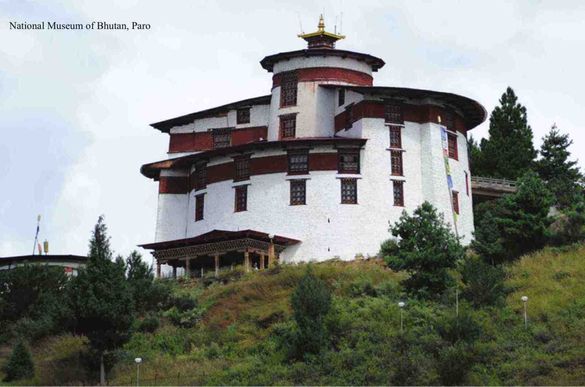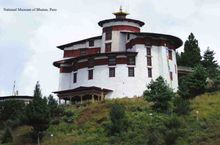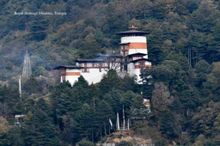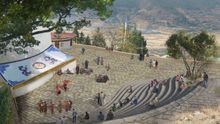 23 Sep 2025
23 Sep 2025
Tags: Bhutan, Fundraising, Philantrophy, Museums, Culture, Heritage

Safeguarding Bhutan's Heritage: Inspiring Generations, Connecting Humanity
The Museums of Bhutan, comprising the National Museum of Bhutan in Paro, the Royal Heritage Museum in Trongsa, and Ta Dzong, Trashigang are poised to embark on a transformative chapter to make Bhutan's culture more accessible on a global scale. Guided by the Gross National Happiness (GNH) values, the #MeritThatBlooms global fundraising campaign launches on Give.Asia to inspire a spirit of generosity and shared purpose.
Funds raised through the campaign will support the transformation of the Museums of Bhutan into dynamic living cultural hubs—spaces that safeguard Bhutan's rich traditions while empowering the next generation of Bhutanese youth to become “Guardians of Culture”.
Preserving Heritage in a Changing Bhutan
Bhutan, celebrated as the last 'Shangri-la', captivates the world with its spiritual traditions and pristine landscapes. Yet the Kingdom stands at the crossroads:
- By 2027, Bhutan is projected to become an aging society (UNFPA*)
- Youth migration is rising as young Bhutanese seek opportunities abroad, risking a disconnect from their cultural roots
In response to these challenges, the Department of Culture and Dzongkha Development, Ministry of Home Affairs, Royal Government of Bhutan is revitalizing its museums by transforming outdoor spaces into living cultural hubs
The vision includes:
- Regenerative outdoor spaces harmonising with Bhutan's Himalayan landscapes.
- Immersive venues for festivals, gatherings, and global dialogues, blending tradition with innovation.
Tshering Uden Penjor, Chief Curator, Museum Division, Department of Culture & Dzongkha Development said: "Through the integration of nature into our museum environments, we will create regenerative spaces that nurture reflection, growth, and renewal for visitors. We are transforming our Museums of Bhutan into vibrant third places beyond walls— outdoor sanctuaries where Bhutan's culture and wisdom of our past can flourish. The enhancements of our museum ecosystems will empower Bhutanese youth to become 'Guardians of Culture,' embracing the values of compassion, ecological stewardship, and cultural preservation to foster a sustainable and harmonious future."
Yu Ming Pong, Co-founder of Give.Asia said:”At Give.Asia, we believe in the collective power of individuals who give, act and care. Bhutan's vision for a harmonious future, where mind, body, and soul thrive in balance with nature, resonates globally. By providing a trusted platform for global contributions, Give.Asia empowers individuals from all corners of the world to unite with a shared purpose and contribute to the 'Building Fund for the Museums of Bhutan', nurturing a legacy of cultural preservation, sustainable living, and holistic wellbeing for generations to come.”
As part of its ongoing transformation, the National Museum of Bhutan in Paro opened a new DSP Cafe in October 2024. Offering views of Paro Valley, the café offers visitors an inviting space to enjoy beverages and snacks while basking in the warmth of Bhutanese hospitality. Managed by young Bhutanese participating in the De-suung Skilling Programme (DSP), an initiative launched by His Majesty King Jigme Khesar Namgyel Wangchuck, the café is a showcase of how Bhutan supports its youth. DSP youth volunteers who have completed their training are offered jobs, such as those at the museum café, allowing them to gain practical skills necessary to thrive in a rapidly evolving economy, fostering self-reliance, innovation, and community engagement.
Heartware for Sustainable Development
Amid the challenges of climate change and rapid modernization, Bhutan's unwavering commitment to cultural preservation offers a powerful blueprint for sustainable development. As the world's first carbon-negative country, Bhutan demonstrates how environmental stewardship and cultural continuity can go hand in hand—creating a model of progress rooted in values, resilience, and meaningful global impact.
Furthermore, for the Bhutanese diaspora, the museums' enhancements can help them stay connected to the values that shape their heritage, regardless of where they are in the world By deepening its efforts for heritage preservation, Bhutan sets a powerful example of how nations can balance progress with respect for their cultural roots, creating a lasting impact on both the environment and society.
A newly launched Building Fund for the Museums of Bhutan campaign on Give.Asia aims to raise contributions through philanthropic donations to revitalize the museums' outdoor spaces, creating inviting environments where visitors can engage with Bhutan's way of life.
For more information, visit www.museums.gov.bt.
*United Nations Population Fund (UNFPA): Bhutan's elderly population is projected to reach 7.4 % of the total population by 2017.
About Give.Asia
Give.Asia is one of Asia's leading digital fundraising and kindness platforms, founded in 2009 with a vision to make everyone a giver. By combining technology with compassion, the organisation empowers individuals and communities to support causes they care about — from urgent medical needs to grassroots social impact.
To date, Give.Asia has helped raise over SGD 130 million, making it a trusted platform for donors, charities, and changemakers across the region. Beyond fundraising, the platform helps drive volunteerism and advocacy through digital tools, content storytelling, and youth engagement programmes that inspire action on the ground.
About the Building Fund for the Museums of Bhutan
The Museums of Bhutan Transformation Project is a forward-thinking initiative to redefine the outdoor museum experience in the world's first carbon-negative country. The goal is to raise US$12 million through a global fundraising campaign to build versatile outdoor venues for cultural gatherings, international conferences, and private events. Druk Asia, in partnership with the Department of Culture and Dzongkha Development, Ministry of Home Affairs, is spearheading the fundraising initiative to revitalize the Museums of Bhutan: the National Museum of Bhutan in Paro, the Royal Heritage Museum in Trongsa, and Ta-Dzong, Trashigang, an excavated archaeological site.
Individuals, corporations, and philanthropists are invited to support the Museums of Bhutan in cultivating outdoor sanctuaries that promote regenerative thinking, community engagement, and mindfulness through immersive cultural experiences deeply rooted in Bhutan's Gross National Happiness (GNH) values.
ANNEX A
Through the newly launched 'Building Fund for the Museums of Bhutan', the Department of Culture and Dzongkha Development envisions a future where Bhutan's rich heritage is preserved, generations are united through shared stories, and cultural vitality continues to shape the nation's social and spiritual growth.
The Building Fund for the Museums of Bhutan will focus on enhancing three museum sites:
- National Museum of Bhutan, Paro: The historical watchtower of Paro showcases Bhutan's spiritual and cultural legacy through its diverse exhibits.
- Royal Heritage Museum, Trongsa: Situated in the Ta Dzong of Trongsa, this museum is dedicated to the Bhutanese monarchy. It was opened in 2008 to commemorate a century of reign under the Wangchuck dynasty.
- Ta-Dzong, Trashigang: Situated in the eastern part of the country, Trashigang is one of the most historically significant areas in Bhutan. The site where the former Ta-Dzong was situated embodies the region's role in protecting and preserving Bhutan's sovereignty and spiritual values. The unexcavated site will be transformed into an archaeological museum.
Funds raised will be allocated for:
- Construction expenses of outdoor infrastructure and facilities at museum sites, including an amphitheater for hosting large-scale events at the National Museum of Bhutan
- Construction of outdoor rest areas at museum sites
- Incidental costs relating to planning, negotiating, financing and obtaining approvals for acquisition or construction
- Landscaping, repairs, painting, plumbing and general maintenance of the museums including costs of purchasing associated equipment
- Building insurance, to the extent it relates to the museums
- Administration costs of establishing or promoting the fund, including bank fees, accounting and audit costs, fundraising expenses and reasonable remuneration for the building fund's administrator and staff.




